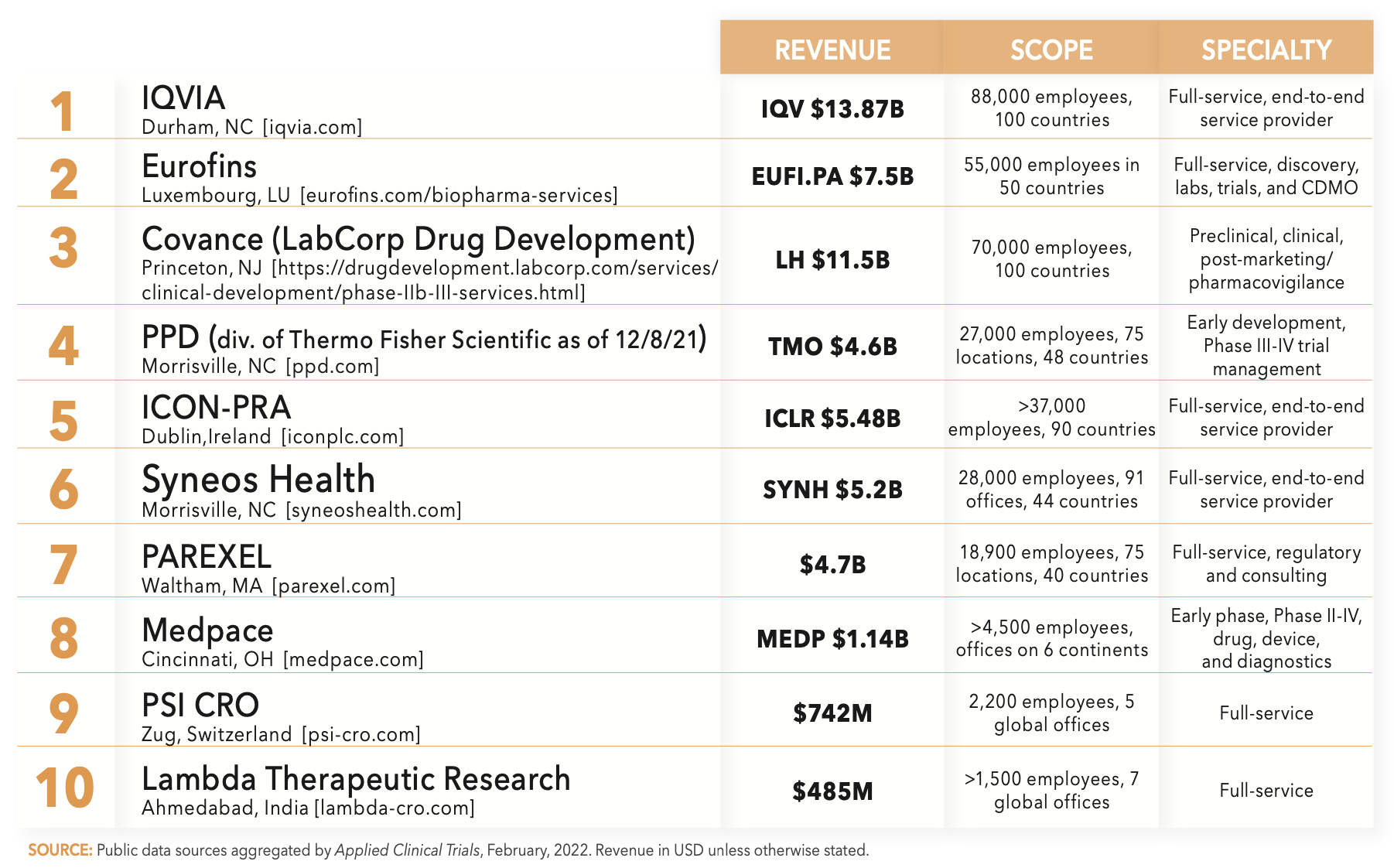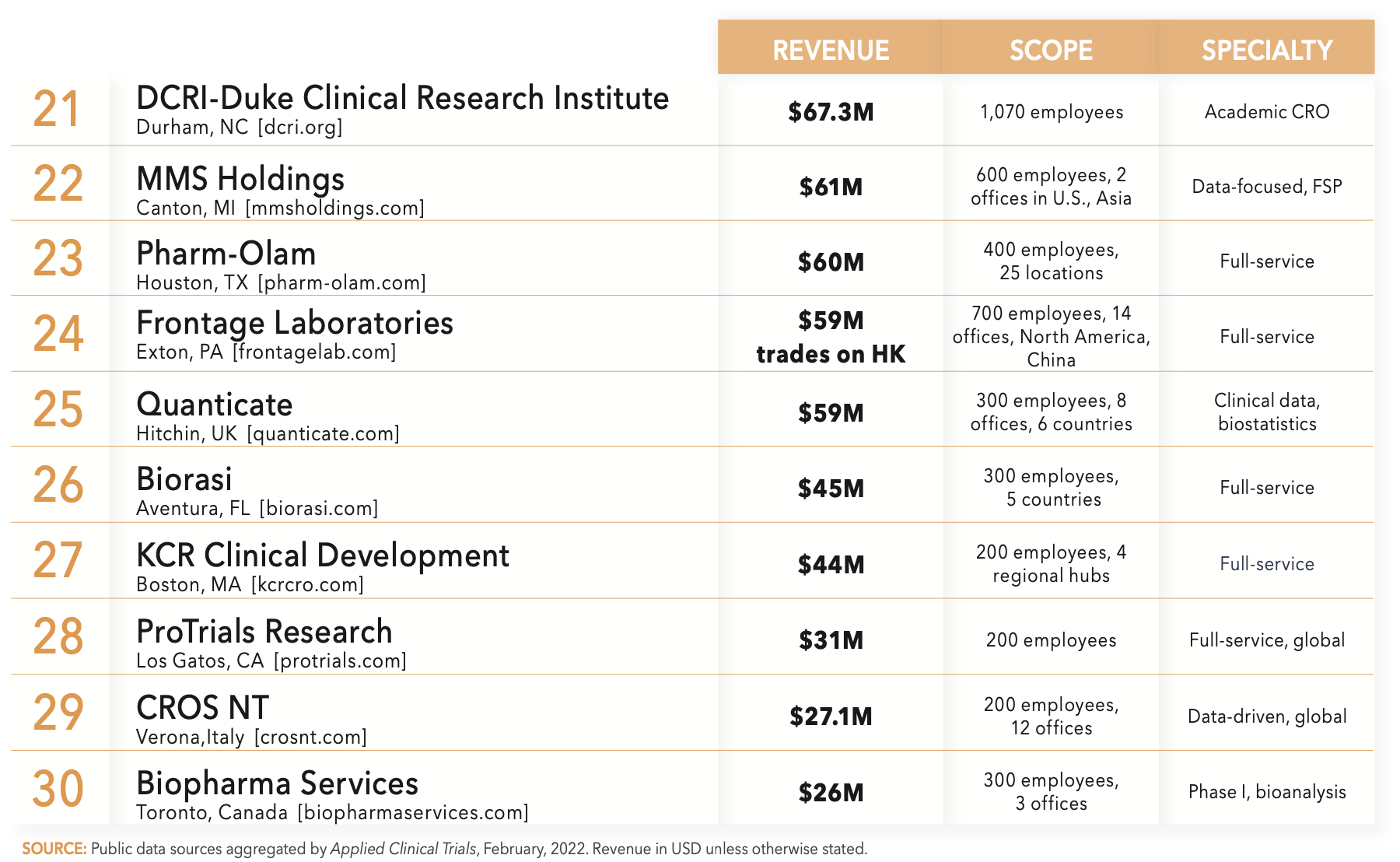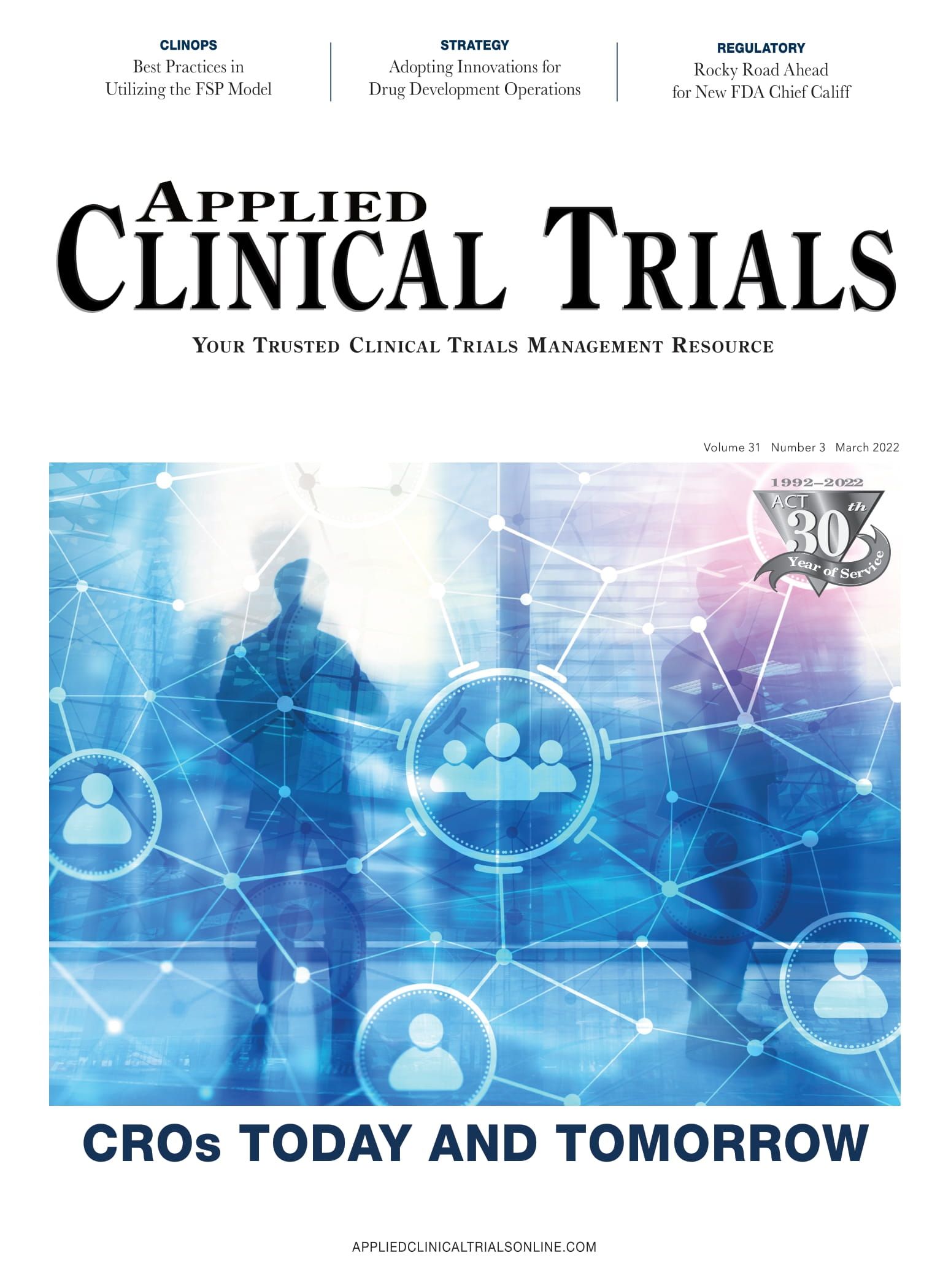CRO Update: Where are Contract Research Organizations Headed?
How CROs have adapted to recent challenges—and how they’ll continue to evolve in the future.
Contract research organizations (CROs) have undergone significant changes in recent years, and even more changes are on the horizon. Some of the new and established trends in CROs are the result of technological advances, while others have arisen in response to market pressures or the COVID-19 pandemic. Experts say that spending on research and development has continued to grow over the last 15 years, even as the pandemic has caused biotech stocks to slump. However, CROs continue to face a variety of challenges, from competitive pressure to commoditization to evolving patient engagement models. Market stratification is placing pressure on smaller CROs to niche down or subcontract as larger organizations capture more of the market. As CROs navigate a post-pandemic future, there will be opportunities to implement lessons learned from COVID-19 and adopt emerging technologies that can improve data management, mitigate staffing shortages, or facilitate better patient monitoring and engagement.

The CRO market is in a state of flux, and navigating the changes in this industry will require improvisation and good planning. Here are some of the recent trends and emerging challenges for CROs.
M&As create David vs. Goliath dynamic
The CRO space has seen a flurry of merger and acquisition activity in recent years. 2016 saw the merger of IMS Health with Quintiles, resulting in the birth of IQVIA. In February 2021, ICON entered into an agreement to acquire PRA Health Sciences. In December 2021, instrument and software supplier Thermo Fisher Scientific finalized a deal to buy CRO PPD.
While these deals have helped the industry’s largest players scale up services, they’re also putting pressure on smaller CROs.
Ken Getz, MBA, is director and research professor at the Tufts Center for the

Study of Drug Development at Tufts University in Boston, MA. Getz says that these and other deals have enabled large CROs to consolidate expertise and resources.
“In a commoditized service area, scale is important, because it gives you a depth of business development and sales coverage in the market,” Getz explains. “It becomes harder for niche players to function, because without scale, they can’t match the price points and the muscle that larger companies can throw into every project. Some of the smaller CROs are getting squeezed out, while others are becoming subcontractors to larger CROs.”
Getz says that some small CROs may be able to resist this competitive pressure, provided they can specialize in a well-differentiated niche service like a specific type of biostatistics. However, niching down also puts smaller CROs farther away from the end client; these specialized CROs, Getz says, would be selling themselves as subcontractors to the industry’s Goliaths. Still, there may be a middle path forward for small- and mid-sized full-service CROs.
“Some of these smaller CROs will argue that they want to offer outsourcing that’s provided by a vendor similar in size to the client they’re serving,” Getz says. “That’s called right-sizing. Historically, right-sizing has been a successful strategy, but only with select companies—and it’s hard to predict who those companies will be.”

John Kreger, an equity research analyst with William Blair in Chicago, IL, says the pharma industry’s source of innovation has aggressively shifted from large pharmaceutical companies to small biotech startups. This change is prompting CROs to rethink their client engagement model to better target young, aggressively-managed startups. The next two years, he says, will see the industry embracing more innovations.
“The CROs will either be leading the effort to innovate, or they’ll be dragged along by their clients,” Kreger says. “A tangible example would be decentralized trials (DCTs). The old model of a clinical trial had the patient come to the doctor’s office once a month for two or three years. But now, with technology like Zoom and wearables, we can do patient visits from home.”
Kreger says tech-enabled CROs are growing, and they’re more broadly deploying technologies that were battle-tested during the COVID-19 pandemic.

Could labor give way to technology?
Emerging new technologies could reshape clinical trials over the long term. Kreger says that technology adoption will become more ubiquitous over time; while CROs are only just now starting to look at novel technologies like artificial intelligence (AI) and machine learning, Kreger says this decade will see CROs continue to incorporate more of these technologies. As technological adoption grows, CROs will become less dependent on labor.
“Within artificial intelligence, there’s a field called biosimulation that involves running trials on a computer before running them in the real world,” Kreger explains. “I think technology will make trials and CROs more efficient. But this will increasingly be a biotech landscape. The notion of virtual pharma companies, which was a term thrown around loosely before, is becoming more and more real. You don’t need to be Merck to do this; you can be a small innovator and have outsourcing partners for each functional step.”
Kreger hypothesizes that as technology grows, the CRO model may change from a labor-driven model to a technology-driven one. If this were to occur, CRO operations would rely less on people and more on software. The competitive differentiator between CROs, then, wouldn’t be who has the best people, but rather, whose technology can best capture, sort, and utilize data.
Pandemic, worker shortage demand flexibility

The COVID-19 pandemic and a shortage of skilled workers have put pressure on CROs to change the way they conduct studies, and new technology is already making research more flexible. Eric Coldwell, managing director, equity research at R.W. Baird in Chicago, says that while other technologies like machine learning and AI are growing, DCTs are the single-most important trend in the CRO space today. AI and advanced data analytics may offer future innovations, but Coldwell says that DCT technology is solving a current problem.
“The most important topic of 2022 is DCTs, full stop,” Coldwell says. “If you can’t do research at a traditional site, you have to be able to do it somewhere else. What’s really interesting is that different CROs have different approaches to DCT. IQVIA claims it can do just about everything internally with its proprietary technology. Covance has traditionally worked with outside vendors, but they bought snapIoT in 2020. But then you have other companies that would rather partner with channel-agnostic technology leaders, or just be flexible and work with everyone.”

Coldwell cites the examples of CROs PPD and Syneos. Both organizations have partnership agreements with Science 37, a clinical research firm specializing in DCTs. Syneos also has a deep relationship with Medidata. Coldwell says most CROs will forge partnership agreements with DCT software developers, but three or four of the world’s largest CROs are building DCT technology in-house. These technology solutions, Coldwell says, are part of a larger trend that aims to increase the flexibility of clinical trials.
“I don’t think you can plan for COVID-19 interruptions, other than to be as flexible as possible with your approach to a trial,” Coldwell says. “We’re two years into the pandemic now. We’ve found ways to keep important trials going. Trials went from 90% closed at the start of the pandemic to 80% open today, but the reality is that 20% of study sites have always done 80% of the world’s work. We can survive with 80% of study sites open. But the big change has been this incredible growth in tools that allow a patient to visit a study site less frequently.”
Coldwell says governments and review boards have been very flexible with new technology and methodology solutions that enable fewer in-person study visits. The message from the review boards is that researchers should do what makes the most sense to keep a trial running—especially when patient welfare is at stake.
“If you have a patient who will be severely harmed if they’re denied access to an investigational drug, then you need to change the protocol,” Coldwell says. “The review boards have said, ‘don’t ask for permission, tell us what you did and then ask for forgiveness.’”
Sponsor preferences bog down trials
While technology has enabled CROs to conduct hybrid clinical trials involving online and in-person components, these trials come with their own challenges. Despite offering the advantage of fewer study visits and easier patient access, Getz says hybrid trials are demanding and difficult to run because they require CROs to juggle multiple different patient preferences and execution models simultaneously.
“Hybrid clinical trials aren’t making research easier for anyone,” Getz says. “A hybrid trial requires a more agile mindset, where you can adapt quickly and prepare to manage multiple executional models that you deploy at the same time. Sponsors and CROs are struggling with it.”
Getz says that while CROs have been trying to move clients away from traditional methods and toward emerging tools, these efforts have historically resulted in significant pushback. Sponsors have typically expected that CROs will fall in line with the sponsor’s own standard operating procedures. While some CROs have forged deep enough relationships with clients to gain a certain degree of latitude, Getz says that the CRO is still required to follow the sponsor’s procedures and operational requirements in many cases. This trend has continued despite hard evidence demonstrating that more flexibility from sponsors would create better results.

“We’ve gathered a lot of data at the Tufts Center that consistently shows that CROs are faster and more efficient than comparable studies managed by sponsors’ own internal teams,” Getz says. “We’ve been sharing those findings for decades, and it doesn’t seem to have influenced sponsor preferences for when and when not to outsource. The general position that most pharma companies take is that they need to provide a level of oversight where they limit the CRO’s ability to take latitude, to do things that are novel and different.”
Supply chain disruptions prompt anticipatory planning
The COVID supply chain crunch has affected nearly every sector. In June 2021, the White House published a report explaining the various factors affecting supply chains, from labor shortages to low inventory and beyond. In September 2021, McKinsey & Company noted that the pharmaceutical industry is vulnerable to region-specific supply chain interruptions like natural disasters. Disruptions are increasingly common and increasingly global, and high inventory alone is insufficient to guard against supply chain shocks.
Kreger says that CROs are hired to solve problems and keep trials on track. While all trials come with challenges, and while the pandemic has meant nearly every clinical trial has had some kind of crisis, Kreger says that solving problems is—or ought to be—the core skill of CROs.
Getz says that managing supply chain disruptions involves anticipatory planning, and several of the larger CROs are already quite effective at anticipating and resolving shortages. However, smaller CROs are more likely to struggle with these issues:
“The larger CROs have the resources to stockpile supplies or accommodate for when things get pinched down the road. The smaller CROs don’t have the resources or the infrastructure to monitor supply chains and mitigate shortages.”
Demand for CRO services to increase
Despite challenges such as controlling sponsors, a labor shortage, and market consolidation, the CRO industry will continue to be buoyed by growing demand for outsourced R&D services. Coldwell says that the main factors driving CRO performance over time have involved Big Pharma outsourcing more of their work, new biotech startups gaining financing, and regulators asking for more data and imposing more protocol requirements. He points to several other economic drivers that are also contributing to the growing need for CROs, including a more crowded pharmaceutical marketplace and a push by pharma companies to find better competitive differentiators.
“I’ve covered CROs for 27 years, and I don’t think we’ve ever seen a year where outsourcing didn’t either hold ground or gain ground in terms of market penetration,” Coldwell says. “There was a mass acceleration of outsourcing due to COVID-19, and I don’t see pharma companies bringing work back in-house. I also don’t see regulators asking for less data. What I don’t know, and where there is some debate, is what will be the ultimate impact of this rapid transition toward more fully decentralized trials.”
Coldwell expects that over time, as CROs become more effective at running DCTs, those studies will become faster and more efficient. While this shift would mean less revenue from an individual trial, Coldwell says it would also mean fewer delays, fewer change orders, and less clean-up work. As DCTs become faster and less expensive to run, he says, pharmaceutical companies may spend more money on DCTs to get more drugs to market faster.
“The debate isn’t whether there will be a lot of activity,” Coldwell explains. “There will be. The real debate in five or 10 years is whether decentralized trials will be successful enough and rolled out broadly enough to increase revenue.”
While the jury is still out on DCT revenue, past investments in mRNA, antibody therapies, autoimmune products, vaccines, oncology, and various other fields have already created tremendous demand for outsourced services. Coldwell says this increase in demand is reflected in the CRO industry’s revenue growth numbers.

“The publicly-traded CROs are looking at a 2021 revenue growth that’s close to 30%,” he notes. “The aggregated year-over-year growth of those companies is going to be in the mid-to-high 20s, which is pretty amazing. Before the pandemic, a typical growth expectation was about 6% to 8%. We’re seeing growth rates in 2022 that are beyond what was expected in 2018.”
CROs set for seismic shifts
The CRO industry is undergoing rapid growth and significant changes. While growing investment in pharmaceutical R&D is creating more opportunities for CROs, smaller players are facing competitive pressure from larger companies that have undergone recent mergers. Supply chain disruptions and labor shortages are contributing to a more challenging environment, but analysts say that CROs have the tools and creativity to solve these problems—if sponsors will accept the need for innovation. Still, the emergence of DCTs and advanced technologies are giving CROs new tools to meet demand.
In the near term, the future of the CRO industry will see companies learning lessons from COVID and implementing more technology-driven solutions. By the end of this decade, analysts say CROs will invest in AI-powered biosimulation, consolidate clinical and commercial divisions, and ramp up hybrid trials. While there will be pressure to differentiate or niche down, and to ensure services are competitively priced, a smaller slice of a bigger pie is still more pie.
Mike Straus, Freelance Medical Writer
